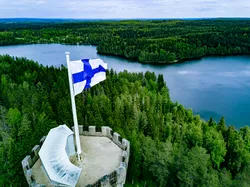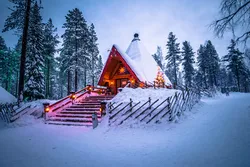See all articles relating to: Finland

Finland is a country in Northern Europe with a rich history dating back to prehistoric times. In the Middle Ages, Finland was under Swedish rule, and it wasn't until the 19th century that it gained autonomy as a Grand Duchy within the Russian Empire. During World War II, Finland was invaded by the Soviet Union, but managed to resist and retain its independence. Notable Finnish figures in history include Johan Ludvig Runeberg, a national poet who wrote the lyrics to the Finnish national anthem, and Jean Sibelius, a renowned composer whose music is still celebrated today. Another notable figure is Martti Ahtisaari, a former President of Finland who won the Nobel Peace Prize in 2008 for his work as a peace negotiator and mediator in various conflicts around the world.
Research your ancestors on MyHeritage
The regions of FinlandThe regions of Finland
Finland is divided into 19 regions:
- Lapland (Lappi/Lappland)
- Kainuu (Kainuu/Kajanaland)
- North Ostrobothnia (Pohjois-Pohjanmaa/Norra Österbotten)
- Northern Savonia (Pohjois-Savo/Norra Savolax)
- Southern Savonia (Etelä-Savo/Södra Savolax)
- North Karelia (Pohjois-Karjala/Norra Karelen)
- South Karelia (Etelä-Karjala/Södra Karelen)
- Kymenlaakso (Kymenlaakso/Kymmenedalen)
- Päijänne Tavastia (Päijät-Häme/Päijänne Tavastland)
- Tavastia Proper (Kanta-Häme/Egentliga Tavastland)
- Pirkanmaa (Pirkanmaa/Birkaland)
- Satakunta (Satakunta/Satakunda)
- Southwest Finland (Varsinais-Suomi/Egentliga Finland)
- Ostrobothnia (Pohjanmaa/Österbotten)
- Central Ostrobothnia (Keski-Pohjanmaa/Mellersta Österbotten)
- South Ostrobothnia (Etelä-Pohjanmaa/Södra Österbotten)
- Central Finland (Keski-Suomi/Mellersta Finland)
- Uusimaa (Uusimaa/Nyland)
- Helsinki-Uusimaa (Helsinki-Uusimaa/Helsingfors-Nyland)
Each region is governed by a regional council, which is a coalition of the municipalities in the region. These regions are not political entities like U.S. states or German Länder, but they do have some autonomy in planning and development.
Finnish historyFinnish history
Finland was very remote from the main centers of western civilization in the Mediterranean during ancient times and features very little in written records prior to the Middle Ages. Indeed the Romans and Greeks appear to have believed that Scandinavia was an island, which is indicative of their lack of knowledge about the land bridge which existed between what is now north-western Russia through Finland to northern Sweden. However, the first-century CE Roman historian and anthropologist Tacitus did refer to the ‘Fenni’ as living far to the north.[1]
Although a part of Scandinavia, Finland was not central to the Viking Age migrations which occurred at what was the end of the Norse Iron Age. Rather the great majority of those who sailed to Britain, Ireland, France, Spain, Iceland, Greenland and down the great rivers of Eastern Europe to Ukraine, the Black Sea and the Caspian primarily came out of Sweden, Denmark and the fjords of Norway. But the Viking Age did have the impact of drawing Finland closer into European diplomatic and trade connections. During the High Middle Ages the country’s long history of domination by its more powerful neighbors began when Finland was made a part of the Kingdom of Sweden. Swedish domination also brought with it Christianity in the course of the twelfth and thirteenth centuries.[2]
During the early modern period Finland continued to be a part of the Kingdom of Sweden and found itself at the frontlines of a conflict between Sweden and the emerging Russian state for dominance of north-eastern Europe. Russia gradually annexed parts of Finland during the Northern Wars of the seventeenth and eighteenth centuries, but it was not until the Finnish War of 1807/8 that Russia prized the country from the Swedes and turned it into the Grand Duchy of Finland ruled by the Russian Tsars.[3]
Finland managed to finally acquire its independence after centuries of foreign domination in 1917. It did so by taking advantage of the Russian Revolution and Civil War and for a time became the base of operations for Vladimir Lenin and the Bolsheviks in the summer and autumn of 1917. The new Finnish state elected to become a republic. It very nearly came to an end in the early stages of the Second World War when the Soviet Union attempted to re-impose control over what was deemed to be a ‘lost’ territory. However, the Finns resisted Russian encroachments during the Winter War of 1939/40 and unlike so many of the Soviets’ other neighbors also avoided being drawn into the Warsaw Pact during the Cold War. The country has emerged as one of the most affluent and socially liberal countries in the world today.[4]
See also: Finnish history
Finnish geographyFinnish geography
Finland is the sixth largest country in Europe (excluding Russia) and is approximately twice the size of Britain. Yet, Finland’s size is not reflective of its population or economic productivity. Much of the country is made up of lakes and extensive forests, while one-third of Finland lies inside the Arctic Circle. Moreover, this frozen region to the north is also an upland plateau and consequently, few people live here. Lakes make up 10% of the country and over 60% of Finland is still forested today.[5] Most of the population centers and economic heartlands lie in the south and south-west along the coasts of the Gulf of Finland, the Gulf of Bothnia and the Baltic Sea. The wider metropolitan area of the capital Helsinki accounts for nearly 30% of the country’s 5.7 million people alone. This is a land of extensive sunlight during summer. In June and July Helsinki, for example, has a night-time which lasts just two to three hours owing to its northerly position, while further to the north there are parts of Finland which do not experience night for over two months during the summer.[6]
See also: Finnish geography
Researching family history in FinlandResearching family history in Finland
Owing to its long history of domination by its neighbors, Sweden and Russia, much of the documentary material for the study of family history of genealogy in Finland during the early modern period and much of the modern period too is found in archives outside of Finland itself, specifically in Stockholm, St Petersburg and Moscow. The Swedish administrative state was one of the most advanced in the world in early modern times and there is a census available for both Sweden and Finland from as early as 1749.[7] Other records are more local in nature. For instance, the cities and towns of Helsinki, Turku, Vyborg and Oulu carried out their own municipal censuses as early as 1870. A good starting place for any research into family history and genealogy in Finland is the National Archives of Finland.[8]
See also:
- Finnish genealogy
- Finnish immigration
- Finnish emigration
- Finnish archives
- Vital records in Finland
- Birth records in Finland
- Death records in Finland
- Marriage records in Finland
- Census records in Finland
- Civil registrations in Finland
- Church records in Finland
- Newspaper records in Finland
- Military records in Finland
- Finnish tenant farmers (Torppari)
- Finland obituaries
- HisKi project
Finnish ethnicityFinnish ethnicity
Finland is a relatively homogenous country, with the vast majority of its population being ethnic Finns. However, there are also small populations of Swedish-speaking Finns, Russians, and Estonians, among other ethnic groups. The Sami, an indigenous people who live primarily in the northern regions of Finland, Norway, Sweden, and Russia, have their own distinct culture and language.
See also:
Finnish surnamesFinnish surnames

Understanding Finnish surnames is an important part of researching family history in Finland, as they often reflect a person's occupation, location, or other distinguishing characteristic. Unlike in many other cultures, Finnish surnames are not necessarily passed down from one generation to the next. For example, the surname "Mäkinen" means "person from a hill," and the surname "Korhonen" means "person from a grove of trees". Additionally, Finnish surnames may have been changed over time due to various factors, such as spelling errors or the desire to adopt a more Finnish-sounding name. When researching Finnish genealogy, it is important to keep in mind the various surname traditions in Finland, such as the West Finnish, the East Finnish, and that of the Swedish nobility, clergy, bourgeoisie, and military.
Examples of different Finnish surnames include: Virtanen, Nieminen, Laine, Hakala, Järvinen, Koskinen, Saari, and Niskanen
See also:
Explore more about FinlandExplore more about Finland
- Search Finnish historical records at MyHeritage
- A Guide to Scandinavian Records on MyHeritage on the MyHeritage Knowledge Base
- Research Finns – Finnish not required; Internet is! at Legacy Family Tree Webinars
ReferencesReferences
- ↑ https://www.worldhistory.org/Vikings/
- ↑ https://www.britannica.com/topic/history-of-Finland
- ↑ https://finland.fi/life-society/main-outlines-of-finnish-history/
- ↑ https://www.jstor.org/stable/3001208
- ↑ https://www.countryreports.org/country/Finland/geography.htm
- ↑ https://www.britannica.com/place/Finland
- ↑ https://www.stat.fi/tup/vl2010/art_2011-03-18_001_en.html
- ↑ https://en.wikipedia.org/wiki/National_Archives_of_Finland

